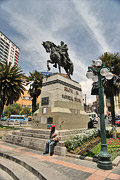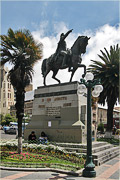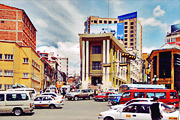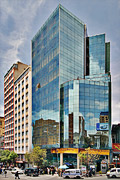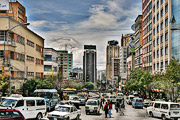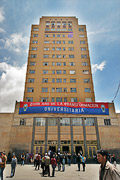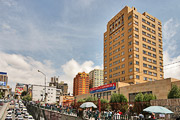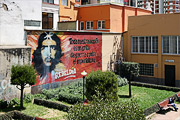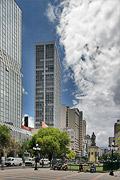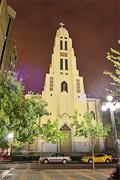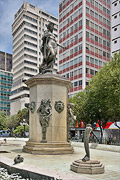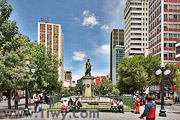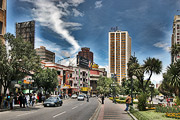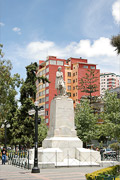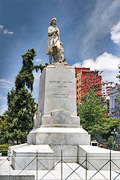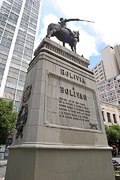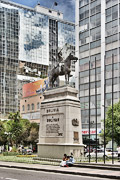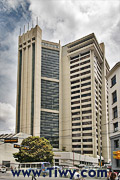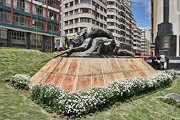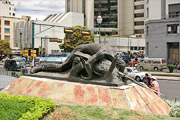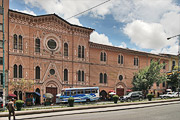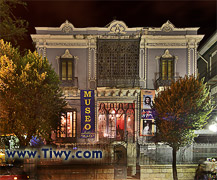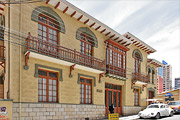Paseo el Prado (aka av.16 de Julio), av.Mariscal Santa Cruz, La Paz, Bolivia
Some photos from Paseo (boulevard) El Prado are presented at this page. Paseo, which is also called July 16 street (av.16 de Julio), gradually merges into the Avenida Mariscal Santa Cruz. As a whole these streets, running along the bed of the ancient river, are the main transport thoroughfare of La Paz that crosses its central part.Before viewing I recommend to get familiar with the map and find Plaza del Estudiante (Square of Student) (Green circle with figure 3).
Plaza del Estudiante at day time and at night:
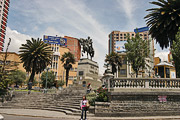
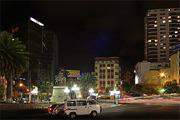
A three meter high monument to Marshal Antonio Jose de Sucre (1795-1830), made by an Italian Enrico Tadolini (1888-1967), was placed on the Square of Student in 1926. Interestingly enough but the sculptor was a great grandson of sculptor Adamo Tadolini, the author of monuments to Simon Bolivar erected in the capitals of Peru and Venezuela – in Lima and Caracas.
The bust to Sucre that stood at the square since 1902, was shifted to the square of the same name just in a few quarters from here, which is also known as the San Pedro square, because the San Pedro prison is situated at one of its sides.
The monument to Marshal Antonio Jose de Sucre:
A three meter high monument to Marshal Antonio Jose de Sucre (1795-1830), made by an Italian Enrico Tadolini (1888-1967), was placed on the Square of Student in 1926. Interestingly enough but the sculptor was a great grandson of sculptor Adamo Tadolini, the author of monuments to Simon Bolivar erected in the capitals of Peru and Venezuela – in Lima and Caracas.
The bust to Sucre that stood at the square since 1902, was shifted to the square of the same name just in a few quarters from here, which is also known as the San Pedro square, because the San Pedro prison is situated at one of its sides.
Plaza del Estudiante connects six streets, that is why the traffic there is always busy.
There is a municipal library (yellow building with columns on the photo to the left) near the square.
At the other side there is a modern mirror building with posters «Futuro de Bolivia» (Future of Bolivia). It is a commercial pension fund.
If you look from Plaza del Estudiante to the opposite from Paseo El Prado direction, you will see the Villazon street. If you walk half a quarter along this street, on the left there will be a university Mayor de San Andres.
Universidad Mayor de San Andres (UMSA) is the largest one in Bolivia, whereas by seniority it only yields to the university of San Francisco Xavier in Sucre.
It was opened on October 24, 1830. The modern building that is called Monoblock they started to build in 1942 and completed in 1947. Emilio Villanueva Peñaranda (1882-1970) was the architect of the design, who nowadays is called the father of neotiwanakota style
The university Monoblock opened building of high-rise buildings in La Paz. Emilio Peñaranda took part in designing and construction of La Paz area called Miraflores, first stadium, buildings of Central bank (nowadays there is a vice-presidency there) and mayor's office as well as many others that determined the modern image of La Paz.
The portrait of Ernesto Che Guevara on the wall in the university garden exists for more than two dozen years. Many a time they tried to cover it with paint, destroy, but every time the heroic guerilla rose like Phoenix of struggle with imperialism from its ashes.
We start a walk along Paseo El Prado. The boulevard is filled with people from the early morning till late evening. It is not only the most comfortable place in the city with a big choice of resources: coffee shops, restaurants, museums, etc., but also a safe place – everywhere you can see policemen on duty, military patrols, security guards. Here there are always a lot of foreigners, and not only from the North America and Europe, but also local, Latin Americans from Brazil, Argentina, Peru, Venezuela, Chile.
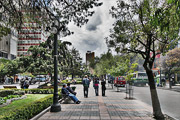
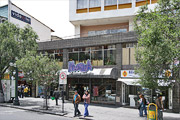
The atmosphere of peace and special positive mood reigns at Paseo. That is why dreamers, lovers, romantics and even businessmen come here to discuss the current affairs and business schemes.
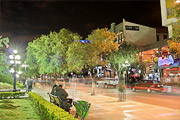
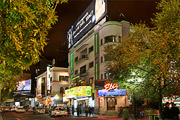
The monument to Madre Patria (Mother Homeland). The most ancient monument of La Paz among the existing ones was erected in 1901.
Henry Allouard (1844-1929) is its creator. Not long ago there was a fountain around it, but now it does not work due to saving of water.
No capital in the world has such cosmic skies as above Paseo El Prado. But residents of La Paz seemed to get used to it and are busy with their daily routine and commonplace things. There is an obvious trace of UFO that flew by, but nobody cares!
The monument to Christopher Columbus, erected in 1926, was created by an Italian sculptor Giuseppe Graciosa. The monument to Columbus more often than others suffers from the hands of vandals. It is smeared with paint and leave inscriptions on it, like «The first colonizer of Indians!» But the «Bolivian» Columbus was lucky – it remained at its traditional place on Paseo, and in Caracas it was ruined by revolutionary masses and nobody knows where it is now.
The monument to Simon Bolivar. It was in honour of him Bolivia got its name.
Central post office of La Paz. There is a pretty good kiosk with stamps, especially on the subject of Bolivian carnival.
Plaza Obelisco.
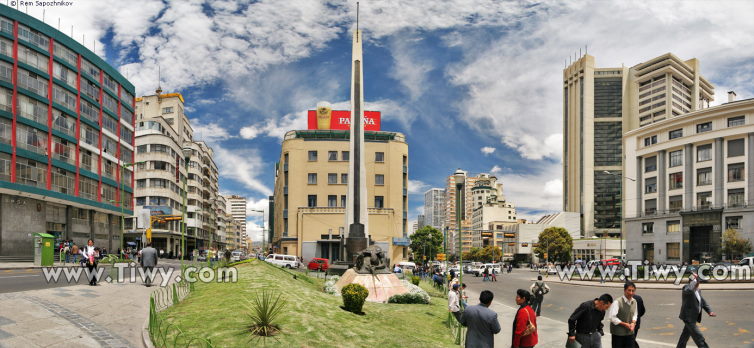
The monument to Al Soldado Desconocido (the Unknown soldier) is linked with a tragic page of the Bolivian history - inglorious Guerra del Chaco (Chaco War) with Paraguay (1932-1935). Bloody battles were held for uninhabited, barren and torrid lands that could «potentially» be oilfields. Instigators of this war were petroleum companies: British-Dutch «Royal Dutch Shell» «supported» Paraguayans, American «Standard Oil» - Bolivians. There is nothing heroic in the monument to the «Unknown soldier». A bronze soldier lies face downwards on the pedestal, exactly like hundreds of other soldiers used to lie along the dusty roads of Chaco. An anonymous, impersonal victim of the war that was unclear and useless for many Bolivians.
Due to unknown reasons in 1979 the monument was shifted to Cementerio General (Central cemetery) of La Paz. The monument to the most famous Bolivian battalion Colorados de Bolivia was erected on its place. On May 7, 2007, the monument to the unknown soldier of Bolivia was returned to its place
Comunidad Educativa Sagrados Corazones.
Walking on El Prado, not far from Plaza del Estudiante, you can drop in a Museum of Contemporary Art Plaza that is open till 21:00.
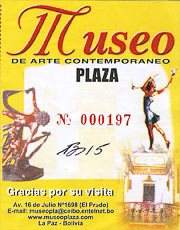
Judging by the represented here ticket one can assume that the attendance of the museum (in the middle of February) was not good – 14-16 people a day! However, somebody might have been let in «for free».
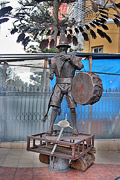 |
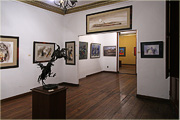 |
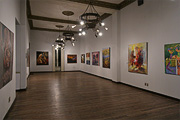 |
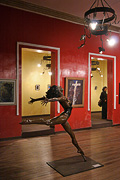 |
Conservatory of La Paz still remains the elite educational center. There are no Indians among its students, but aymara and quechua are very musical people. The world-known melody «El Condor Pasa» was not composed by the privileged graduate of the conservatory in La Paz, Lima or Quito, but by an unknown (genius!) author from the people. By the way, a fiery «Lambada» is also born in Bolivia.

